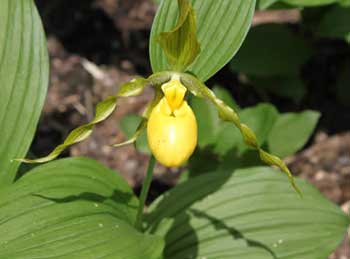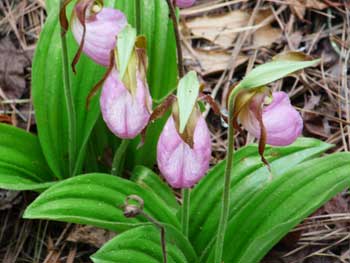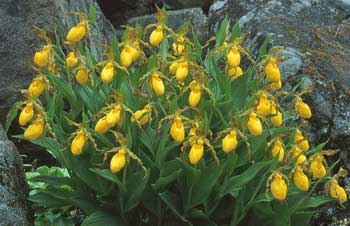Contents:
Common Names | Parts Usually Used | Plant(s) & Culture | Where Found | Medicinal Properties | Biochemical Information
Legends, Myths and Stories | Uses | Formulas or Dosages | Warning | Bibliography
Scientific Names

- Cypripedium pubescens L.
- Cypripedium acaule
- Cypripedium calceolus
- Orchidaceae
- Orchid family
Common Names
Cypripedium pubescens:
- American valerian
- Bleeding heart
- Moccasin flower
- Monkey flower
- Noah’s ark
- Slipper root
- Venus shoe
- Yellow lady’s slipper
- Yellow moccasin flower
- Yellows
Cypripedium acaule:
- Moccasin-flower
- American valerian
Cypripedium calceolus:
- Large yellow lady’s slipper
- American valerian
Parts Usually Used
The root
Back to Top
Description of Plant(s) and Culture

Cypripedium pubescens:
Lady’s slipper is a perennial plant; the fleshy rootstock produces several round, glandular-hairy, leafy stems with alternate, sessile, sheathing, lanceolate leaves which are marked with several nerves. The characteristic flowers, with the lower lip forming an inflated sac suggesting the shape of a moccasin, are golden-yellow and lined with purple. Flowering time is from May to July.
Cypripedium acaule:
Pink lady’s slipper is usually pink, rarely white in some individual plants or populations. It is a perennial, 6-15 inches tall with 2 leaves that are basal. Flowers are strongly veined pouches with deep furrows. Blooms from May to June.
Cypripedium calceolus:
Large yellow lady’s slipper is variable. Mostly it is a hairy perennial, 8-36 inches high. The leaves are broadly lance-shaped; they alternate on the stem. The flowers are yellow, often purple-streaked; blooming May to July.
Back to Top
Where Found

Cypripedium pubescens:
Native to the woods and meadows of North America, from Canada southward to North Dakota, Nebraska and Georgia.
Cypripedium acaule:
Found in acid woods from Newfoundland to Georgia; Alabama, Tennessee, to Minnesota. Too rare to harvest.
Cypripedium calceolus:
Found in rich woods, bogs; from Newfoundland to Georgia; Missouri, Kansas, to Minnesota. Too rare to harvest.
Back to Top
Medicinal Properties
Cypripedium pubescens:
Antispasmodic, diaphoretic, nervine, tonic (no narcotics)
Cypripedium acaule:
Sedative, anti-depressive, nervine (no narcotics)
Cypripedium calceolus:
Sedative, anti-depressive, nervine (no narcotics)
Back to Top
Biochemical Information
Cypripedium pubescens:
Volatile oil, volatile acid, tannic and gallic acids, resins, inorganic salts
Back to Top
Legends, Myths and Stories
This attractive orchid is found in our native woodlands. There are some 50 species that comprise the genus cypripedium, found in Europe, Asia, and North America and as far south as the tropics. There are 11 species found in North America. All species are equally remedial. The roots are believed to have properties very similar to valerian, but with less strength and for this reason sometimes preferred. Like valerian it has no baneful narcotic effects. An old herbal recommends the powdered root in tsp. doses in diluted sugar water or in herbal beverage tisane, such as chamomile flowers, balm tea, lime flowers, etc., as with valerian, the nervine power of lady’s slipper root is increased by combination with other herbs.
Lady’s slipper is also known as nerve root. The medicinal property of the plant was long known by the Native Americans and was a favorite among the empirics of early New England.
Cypripedium pubescens:
Lady’s slipper (C. pubescens) is also called bleeding heart, but the real bleeding heart is named Dicentra spectabilis.
Cypripedium acaule:
Active compounds are not water soluble. The pink lady’s slipper was considered a substitute for the more commonly used yellow lady’s slipper. Orchids often have swollen, ball-shaped tubers, suggesting testicles; these roots are widely regarded as aphrodisiacs.
Cypripedium calceolus:
A related species: C. calceolus var. parvilflora is a smaller plant (to 8 inches high) with a more northerly range. The petals are usually more twisted and burgundy-purple to light brown. It is only slightly hairy compared to its larger relative. Uses are the same as the larger plant.
Back to Top
Uses
Cypripedium pubescens:
A rootstock tea is a good tranquilizer for nervous headaches, general nervousness, low fevers, stomach disorders, epilepsy, tremors, neuralgia, convulsions, insomnia, hysteria, and delirium tremens (DTs). Helpful against cramps and muscle spasms. Taken in large doses, the rootstock may cause hallucinations.
Cypripedium acaule:
Widely used in 19th century America as a sedative for nervous headaches, hysteria, insomnia, nervous irritability, mental depression from sexual abuse, and menstrual irregularities by despondency and PMS. The root has been used as a nerve sedative.
Cypripedium calceolus:
Widely used in 19th century America as a sedative for nervous headaches, hysteria, insomnia, nervous irritability, mental depression from sexual abuse, and menstrual irregularities by despondency and PMS. The root has been used as a nerve sedative.
Back to Top
Formulas or Dosages
The roots should be gathered and carefully cleaned in August or September.
Infusion: steep 5 tbsp. ground rootstock in 1 pint boiling water for 1 hour. Take 1 tbsp. per hour as needed. Or use 1 tsp. rootstock with 1 pint water and take 1 cup per day.
Fluid extract: take 15-25 drops per dose.
Tincture: take 5 to 30 drops, as needed.
Decoction: 3 oz. cut root in 12 oz. cold distilled water; let stand for 2 hours. Bring to a boil and simmer for 15 minutes; strain. Liquid boiled again slowly until it is reduced to 1/2 pint. Bottle and store in refrigerator. This preparation will keep no more than 2 to 3 days. For nervousness, take 1 tbsp. in 1 wineglassful of water 3 to 4 times per day. One tbsp. in warm water is taken at bedtime to promote drowsiness. This herb is not habit forming as narcotics would be.
Back to Top
Warning
Harvesting any of the lady’s slipper plants, which are rare orchids, should be strongly discouraged. As an endangered species it should be used with discretion.
Cypripedium pubescens:
Taken in large doses, the rootstock may cause hallucinations.
The fresh plant can cause severe dermatitis after contact.
Cypripedium acaule:
May cause dermatitis.
Cypripedium calceolus:
All lady’s slipper plants may cause dermatitis.
Back to Top
Bibliography
![]() American Folk Medicine
American Folk Medicine, by Clarence Meyer, Meyerbooks, publisher, PO Box 427, Glenwood, Illinois 60425, 1973
![]() The Complete Medicinal Herbal
The Complete Medicinal Herbal, by Penelope Ody, Dorling Kindersley, Inc, 232 Madison Avenue, New York, NY 10016, First American Edition, copyright 1993
![]() Eastern/Central Medicinal Plants
Eastern/Central Medicinal Plants, by Steven Foster and James A. Duke., Houghton Mifflin Company, 215 Park Avenue South, New York, NY 10000
![]() The Herbalist Almanac
The Herbalist Almanac, by Clarence Meyer, Meyerbooks, publisher, PO Box 427, Glenwood, Illinois 60425, copyright 1988, fifth printing, 1994
![]() The Herb Book
The Herb Book, by John Lust, Bantam Books, 666 Fifth Avenue, New York, NY. copyright 1974.
 How Indians Use Wild Plants for Food, Medicine & Crafts
How Indians Use Wild Plants for Food, Medicine & Crafts, by Frances Densmore, Dover Publications, Inc., 180 Varick Street, New York, NY 10014, first printed by the United States Government Printing Office, Washington, in 1928, this Dover edition 1974
![]() Indian Herbalogy of North America
Indian Herbalogy of North America, by Alma R. Hutchens, Shambala Publications, Inc., Horticultural Hall, 300 Massachusetts Avenue, Boston, Massachusetts 02115, 1973
 The Magic of Herbs in Daily Living
The Magic of Herbs in Daily Living, by Richard Lucas, Parker Publishing Co. (1988).
 Old Ways Rediscovered
Old Ways Rediscovered, by Clarence Meyer, Meyerbooks, publisher, PO Box 427, Glenwood, Illinois 60425, published from 1954, print 1988
![]() Planetary Herbology
Planetary Herbology, by Michael Tierra, C.A., N.D., O.M.D., Lotus Press, PO Box 325, Twin Lakes. WI 53181., Copyright 1988, published 1992
![]() The Yoga of Herbs: An Ayurvedic Guide to Herbal Medicine
The Yoga of Herbs: An Ayurvedic Guide to Herbal Medicine, by Dr. David Frawley & Dr. Vasant Lad, Lotus Press, Twin Lakes, Wisconsin, Second edition, 1988.
![]() Webster’s New World Dictionary
Webster’s New World Dictionary, Third College Edition, Victoria Neufeldt, Editor in Chief, New World Dictionaries: A Division of Simon & Schuster, Inc., 15 Columbus Circle, New York, NY 10023
